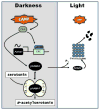N-acetylserotonin: neuroprotection, neurogenesis, and the sleepy brain
- PMID: 22585341
- PMCID: PMC3422380
- DOI: 10.1177/1073858412446634
N-acetylserotonin: neuroprotection, neurogenesis, and the sleepy brain
Abstract
N-Acetylserotonin (NAS) is a naturally occurring chemical intermediate in biosynthesis of melatonin. Previous studies have shown that NAS has different brain distribution patterns from those of serotonin and melatonin, suggesting that NAS might have functions other than as a precursor or metabolite of melatonin. Indeed, several studies have now shown that NAS may play an important role in mood regulation and may have antidepressant activity. Additional studies have shown that NAS stimulates proliferation of neuroprogenitor cells and prevents some of the negative effects of sleep deprivation. It is believed that the antidepressant and neurotrophic actions of NAS are due at least in part to the capability on this molecule to activate the TrkB receptor in a brain-derived neurotrophic factor-independent manner. Emerging evidence also indicates that NAS and its derivatives have neuroprotective properties and protect retinal photoreceptor cells from light-induced degeneration. In this review, the authors discuss the literature about this exciting and underappreciated molecule.
Figures




Similar articles
-
N-acetylserotonin: circadian activation of the BDNF receptor and neuroprotection in the retina and brain.Adv Exp Med Biol. 2014;801:765-71. doi: 10.1007/978-1-4614-3209-8_96. Adv Exp Med Biol. 2014. PMID: 24664769 Free PMC article.
-
N-acetylserotonin activates TrkB receptor in a circadian rhythm.Proc Natl Acad Sci U S A. 2010 Feb 23;107(8):3876-81. doi: 10.1073/pnas.0912531107. Epub 2010 Feb 4. Proc Natl Acad Sci U S A. 2010. PMID: 20133677 Free PMC article.
-
N-acetylserotonin promotes hippocampal neuroprogenitor cell proliferation in sleep-deprived mice.Proc Natl Acad Sci U S A. 2011 May 24;108(21):8844-9. doi: 10.1073/pnas.1105114108. Epub 2011 May 9. Proc Natl Acad Sci U S A. 2011. PMID: 21555574 Free PMC article.
-
The multiple protective roles and molecular mechanisms of melatonin and its precursor N-acetylserotonin in targeting brain injury and liver damage and in maintaining bone health.Free Radic Biol Med. 2019 Jan;130:215-233. doi: 10.1016/j.freeradbiomed.2018.10.402. Epub 2018 Oct 11. Free Radic Biol Med. 2019. PMID: 30315933 Review.
-
Neuroprotective Effects of N-acetylserotonin and Its Derivative.Neuroscience. 2023 May 1;517:18-25. doi: 10.1016/j.neuroscience.2023.02.017. Epub 2023 Mar 8. Neuroscience. 2023. PMID: 36893983 Review.
Cited by
-
The protective effect of alpha lipoic acid (ALA) on social interaction memory, but not passive avoidance in sleep-deprived rats.Naunyn Schmiedebergs Arch Pharmacol. 2020 Nov;393(11):2081-2091. doi: 10.1007/s00210-020-01916-z. Epub 2020 Jun 24. Naunyn Schmiedebergs Arch Pharmacol. 2020. PMID: 32583046
-
A time to remember: the role of circadian clocks in learning and memory.Behav Neurosci. 2014 Jun;128(3):283-303. doi: 10.1037/a0035963. Epub 2014 Apr 7. Behav Neurosci. 2014. PMID: 24708297 Free PMC article. Review.
-
Phenolic Melatonin-Related Compounds: Their Role as Chemical Protectors against Oxidative Stress.Molecules. 2016 Oct 29;21(11):1442. doi: 10.3390/molecules21111442. Molecules. 2016. PMID: 27801875 Free PMC article. Review.
-
Protective effect of N-acetylserotonin against acute hepatic ischemia-reperfusion injury in mice.Int J Mol Sci. 2013 Aug 29;14(9):17680-93. doi: 10.3390/ijms140917680. Int J Mol Sci. 2013. PMID: 23994834 Free PMC article.
-
N-acetyl-serotonin protects HepG2 cells from oxidative stress injury induced by hydrogen peroxide.Oxid Med Cell Longev. 2014;2014:310504. doi: 10.1155/2014/310504. Epub 2014 Jun 12. Oxid Med Cell Longev. 2014. PMID: 25013541 Free PMC article.
References
-
- Allen GC, Earnest DJ. Overlap in the distribution of TrkB immunoreactivity and retinohypothalamic tract innervation of the rat suprachiasmatic nucleus. Neurosci Lett. 2005;376:200–4. - PubMed
-
- Allen GC, Qu X, Earnest DJ. TrkB-deficient mice show diminished phase shifts of the circadian activity rhythm in response to light. Neurosci Lett. 2005;378:150–5. - PubMed
-
- Baler R, Covington S, Klein DC. The rat arylalkylamine N-acetyltransferase gene promoter. cAMP activation via a cAMP-responsive element-CCAAT complex. J Biol Chem. 1997;272:6979–85. - PubMed
-
- Baler R, Covington S, Klein DC. Rat arylalkylamine N-acetyltransferase gene: upstream and intronic components of a bipartite promoter. Biol Cell. 1999;91:699–705. - PubMed
Publication types
MeSH terms
Substances
Grants and funding
LinkOut - more resources
Full Text Sources

